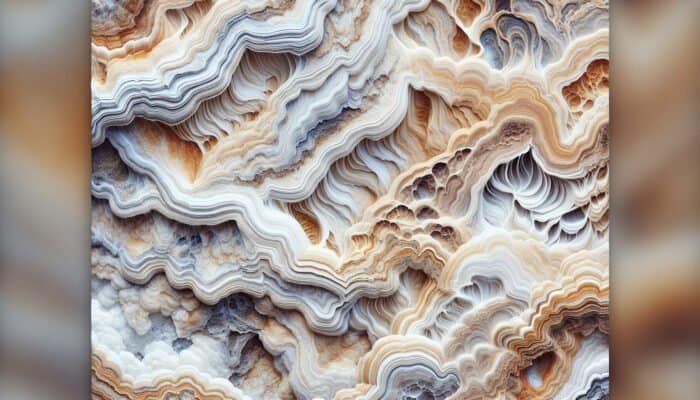Summary of Essential Guide to the Best Fillers for Repairing Travertine Holes:
- Travertine is a porous natural limestone known for its inviting hues and distinctive texture, frequently utilised in UK residences for flooring, patios, and wall installations.
- Over time, its inherent flaws and voids can deteriorate due to moisture, heavy foot traffic, and temperature fluctuations, making timely intervention essential.
- Prompt repairs enhance visual appeal and mitigate damage, safeguarding against water infiltration, staining, and potential structural problems.
- Epoxy-based fillers offer durability and moisture resistance, making them ideal for use in kitchens, bathrooms, and for extensive repairs. They can be colour-matched for a seamless finish but necessitate careful application techniques.
- Polyester resin fillers are user-friendly and set rapidly, making them suitable for DIY enthusiasts and minor interior repairs. However, they are less effective in damp or outdoor settings.
- Selecting the appropriate filler is vital for both aesthetic appeal and long-term durability, especially in areas prone to high traffic or moisture exposure.
Uncovering the Allure and Challenges Associated with Travertine Stone
Top Fillers for Repairing Travertine Holes: Travertine is an exquisite natural stone that infuses warmth and personality into any home environment. The stone's unique texture and rich colour variations derive from the mineral deposits left by hot springs over millennia, rendering each piece unique. This natural beauty has led to travertine becoming a sought-after choice throughout the UK for applications such as flooring, patios, and countertops. However, maintaining its pristine condition can present challenges, particularly as wear and tear become more pronounced over time.
The charm of travertine lies in its organic composition, which typically features small holes and voids formed during its natural creation process. These tiny imperfections can become increasingly visible due to regular foot traffic, moisture exposure, or even slight movements within the stone itself. In bustling households, especially in high-traffic zones, these holes can expand, ultimately compromising both the aesthetic and structural integrity of the surface.
Addressing these holes is a crucial aspect of maintaining travertine's allure. This process not only restores the stone's smooth and polished finish but also revitalises its natural elegance. Equally important, sealing these gaps prevents water from infiltrating and causing more severe damage. Effectively repairing these holes ensures that the stone retains its strength, enabling it to withstand daily use and the unpredictable weather conditions frequently encountered in the UK.
Understanding the Characteristics that Define Travertine as a Natural Stone

Travertine is a naturally stunning stone, cherished for its character and earthy elegance. Formed as minerals precipitate from hot springs, this limestone-based stone showcases a distinctive texture filled with tiny voids. Its warm colour palette ranges from soft creams to deep browns, making it a favoured choice for both indoor and outdoor environments. Numerous UK homes feature travertine, which is a common choice for flooring, patios, and decorative wall features. Its capability to retain heat makes it an excellent companion for underfloor heating systems. Nevertheless, its porous nature can make it susceptible to damage. Exposure to harsh cleaning agents or abrasive tools may result in staining or degradation. To maintain its aesthetic appeal, regular care and sealing are essential components of travertine maintenance.
Identifying the Factors that Lead to Holes in Travertine
One of the defining features of travertine is the presence of small holes and voids that occur during its natural formation. Over time, these imperfections can become more apparent, particularly when subjected to moisture, consistent foot traffic, and temperature fluctuations. In frequently used areas, what may begin as a minor flaw can escalate into a more significant concern.
In regions like the UK, where damp climates can cause water to infiltrate these holes, leading to fluctuating tension and contraction as temperatures shift. This ongoing pressure places additional stress on the stone. Outdoor patios are particularly vulnerable, where heavy furniture or weather exposure can result in cracking and chipping, crucial to identifying these issues promptly to catch any potential problems early.
Understanding the Importance of Repairing Holes in Travertine goes beyond mere aesthetics; it is vital for preserving the stone's structural integrity and preventing further deterioration. If left untreated, holes can accumulate dirt and moisture, leading to staining and weakening of the surface. Over time, this neglect could result in cracks or even crumbling sections of the stone.
By selecting the appropriate fillers and addressing repairs promptly, you can uphold both the beauty and resilience of your travertine. This relatively small investment ensures that your stone continues to shine in any environment, whether indoors or outdoors.
High-Quality Fillers for Effective Repair of Travertine Holes Across the UK

Selecting the appropriate filler for repairing travertine holes can significantly influence the longevity and effectiveness of your repairs. Throughout the UK, various filler options are available, each offering unique benefits suited to different conditions. Understanding which options are most suitable will empower you to address the best filler for your home and the specific challenges you face.
Epoxy-Based Fillers: Exceptional Strength and Longevity
Epoxy fillers stand out as a robust and reliable choice for addressing holes in travertine. Typically available as a two-part formulation, epoxy hardens to form a strong and tear-resistant option. It provides a clean and smooth finish that seamlessly integrates with the stone, particularly when used to fill larger holes or cracks surrounding the stone.
A primary advantage of epoxy is its resistance to moisture and various cleaning agents. This quality makes it particularly suitable for kitchens, bathrooms, or any space prone to spills. Additionally, epoxy can be colour-matched to your travertine, ensuring that repairs remain discreet and visually appealing.
However, it's crucial to apply epoxy correctly. The surface should be thoroughly cleaned and prepared to ensure strong adhesion. Following the provided instructions meticulously and achieving the right mixing ratio is essential for a durable, lasting repair.
Polyester Resin Fillers: User-Friendly and Convenient
If you’re looking for a more accessible option, polyester resin fillers provide a practical solution. They set quickly, are easy to handle, and many are perfect for smaller repair jobs. Many DIY enthusiasts in the UK favour polyester fillers for their quick application and flexibility. Once cured, the filler can be sanded down to achieve a smooth, even surface.
These fillers also come in tintable varieties, allowing you to match the colour to your travertine for a cohesive look. This feature makes polyester fillers an attractive choice for touching up chips or moderate damage throughout the home.
Nonetheless, polyester fillers are not as moisture-resistant as epoxy, making them less ideal for damp environments. For dry, indoor spaces, polyester resin presents a straightforward and visually appealing repair option.
Cement-Based Fillers: Economical and Accessible Solutions

Cement-based fillers are among the most economical choices for filling travertine holes, making them a popular selection for budget-conscious homeowners in the UK. These fillers are readily available at local hardware stores and can be employed to repair both minor and extensive holes. Their affordability and accessibility make cement-based fillers a compelling option for many.
While cement fillers provide a solid repair solution, they may lack the flexibility found in other types of fillers. This rigidity could be a drawback in areas where movement is expected, potentially leading to cracking at the repair site in the future. However, when properly applied, cement fillers can deliver durable and long-lasting results.
Homeowners should also be aware that cement-based fillers may require additional sealing to enhance their moisture resistance, particularly in outdoor settings. Regular maintenance, including resealing, will extend the life of the repairs and help avert future damage. The convenience of sourcing cement fillers from local stores allows homeowners to address issues promptly as they arise, avoiding lengthy delivery wait times.
Acrylic Fillers: Versatile Solprovides for Outdoor Solutioners
Acrylic fillers offer a flexible part, particularly for repairing travertine holes, especially in outdoor applications. Renowned for their adaptability and resistance to weathering, acrylic fillers are well-suited to the UK’s fluctuating climate. These fillers can expand and contract with temperature changes, making them ideal for outdoor patios and driveways where movement is anticipated.
Another significant benefit of acrylic fillers is their wide range of colours and finishes, allowing homeowners to achieve a flawless match with their travertine. This characteristic is especially appealing to those prioritising the visual integrity of their surfaces. The application of acrylic fillers is straightforward, typically requiring only a putty knife for smoothing and shaping the material.
However, while acrylic fillers offer considerable advantages, some users may find them less durable compared to epoxy-based alternatives, particularly in high-traffic areas. Therefore, careful consideration should be given to the specific location of the repair. Overall, acrylic fillers provide a practical and effective solution for areas where flexibility and ease of application are paramount.
Silicone-Based Fillers: Optimal for Moist Environments
Silicone-based fillers are highly regarded for their exceptional adhesion and flexibility, making them ideal for filling travertine holes in damp areas such as bathrooms and kitchens. These fillers create a watertight seal, preventing moisture from penetrating the stone and causing further damage. For homeowners in the UK, this characteristic is particularly beneficial, especially in regions with high humidity levels.
A notable attribute of silicone fillers is their capacity to endure temperature fluctuations without compromising performance. This resilience makes them suitable for both indoor and outdoor applications. Furthermore, silicone fillers are available in a variety of colours, allowing for seamless integration with the surrounding travertine.
However, silicone fillers are generally not recommended for high-load areas due to their softer nature when compared to other fillers. Homeowners should carefully assess where they are applied using silicone fillers, ensuring application in appropriate locations for optimal results. For example, they may excel in sealing gaps around sinks or bathtubs, but may not be suitable for heavily trafficked floor surfaces.
Where to Acquire Travertine Fillers Across the UK
Identifying the right travertine filler in the UK is essential for effective repairs. Fortunately, numerous purchasing options are available, ranging from local hardware stores to online retailers, ensuring that homeowners can find the ideal solution tailored to their needs.
Local Hardware Stores: Quick and Convenient Access
Many local hardware stores throughout the UK offer a selection of travertine fillers, providing a convenient option for those requiring immediate repairs. These stores typically stock popular brands and feature knowledgeable staff who can assist customers in selecting the appropriate product for their specific needs.
Visiting a nearby hardware store allows homeowners to inspect the fillers in person, ensuring they choose a colour and consistency that complements the terracotta. Additionally, allowing stores provide smaller quantities, enabling DIY enthusiasts to purchase only what is necessary for specific expenses without investing in larger, more costly containers.
Local hardware stores often offer community-focused advice on home repairs, including recommendations on the best fillers and techniques for achieving optimal results. This personalised guidance can be invaluable, particularly for novice DIYers who may feel overwhelmed by the range of products available.
Online Retailers: Extensive Variety and Convenience
For those who prefer the convenience of shopping from home, online retailers provide an extensive selection of travertine fillers, often accompanied by customer reviews and ratings to aid informed purchasing decisions. Websites such as Amazon, eBay, and specialised home improvement platforms allow users to compare various products, prices, and brands, ensuring access to competitive pricing options.
The online shopping experience offers distinct advantages, including the ability to read detailed product descriptions and access expert reviews from other customers who have utilised the products. This information can significantly assist shoppers in selecting fillers best suited to their specific repair reqofferts.
Moreover, many online retailers provide rapid delivery options, allowing customers to receive their selected items promptly. However, it is crucial to verify return policies and ensure that products meet quality standards before finalising a purchase, as not all online listings guarantee satisfaction.
Specialised Stone Suppliers: Expert Advice and Premium Quality Products
For those seeking expert guidance alongside their travertine fillers, specialised stone suppliers in the UK present an attractive option. These suppliers often curate a selection of high-quality fillers specifically designed for use with natural stone, ensuring compatibility and optimal performance.
In addition to offering products, specialised suppliers typically employ knowledgeable staff who can provide tailored recommendations based on the specific type of travertine and the extent of the required repairs. This expertise can be particularly beneficial for homeowners undertaking larger projects or those seeking additional guidance on maintenance practices.
Furthermore, many specialised suppliers offer supplementary services, such as consultations for larger renovations or repairs. This can be invaluable for anyone looking to restore or upgrade their travertine surfaces, as well as for those aiming to ensure the longevity and proper care of their investment.
Weighing DIY Repairs Against Professional Assistance for Travertine in the UK
Determining whether to pursue DIY repairs or engage a professional for travertine holes can pose a complex decision for homeowners in the UK. Both options carry distinct considerations, making it crucial to evaluate the specific circumstances and desired outcomes.
Advantages of DIY Repairs: Economical and Fulfilling
Engaging in DIY repairs can be immensely satisfying, as it provides homeowners with a sense of accomplishment and pride in their handiwork. For those who thrive on hands-on projects, repairing travertine holes can be a rewarding endeavour. Additionally, opting for a DIY approach can result in significant cost savings, as homeowners can circumvent the labour fees associated with professional services.
Numerous DIY enthusiasts utilise online resources, including video tutorials and step-by-step guides, to ensure successful repairs. With the right information, tools, and materials, individuals can often achieve impressive results that rival professional craftsmanship.
Moreover, DIY repairs allow homeowners complete control over the process, enabling them to work at their own pace and according to their schedules. However, potential pitfalls exist, particularly for those lacking prior experience. Conducting thorough research and selecting suitable fillers for the specific type of travertine being repaired is essential for success.
When Professional Assistance is Necessary. In some scenarios, rt Knowledge
Some scenarios may necessitate professional assistance when addressing travertine repairs. Complex repairs involving extensive damage or large areas may require expertise beyond the capabilities of DIY enthusiasts. Professionals bring a wealth of knowledge and experience, ensuring that repairs are executed correctly and effectively.
Additionally, homeowners with limited time or those who may feel overwhelmed by the services of professionals consider enlisting a professional's services. This approach alleviates the stress of managing repairs, allowing individuals to focus on other priorities in their lives.
When selecting a professional, it is vital to choose someone experienced in working with natural stones such as travertine. Researching local stonemasons or tiling specialists can yield excellent results, as these professionals typically possess a thorough understanding of travertine’s unique properties and can provide tailored solutions to meet individual requirements.
Identifying a Reliable Professional for Travertine Repairs Across the UK
Finding an experienced professional to handle travertine repairs in the UK can be a straightforward endeavour. Local directories, online listings, and recommendations from friends or family can help in finding reputable specialists in the field.
When evaluating potential professionals, it is essential to review their previous work and assess customer feedback. Many professionals maintain portfolios showcasing their work, providing insight into their capabilities and style. Verifying credentials and experience specifically related to natural stone repairs will ensure that homeowners make well-informed decisions.
Engaging with community groups or forums dedicated to home improvement can also yield valuable recommendations. Networking within local groups can help homeowners discover professionals who have completed similar projects and can deliver the desired results.
Cost Analysis: Comparing Professional Repair Services
When contemplating travertine repairs, understanding the financial implications of DIY versus hiring a professional is crucial. DIY repairs typically involve purchasing fillers, tools, and necessary materials. While some homeowners may find this approach more economical, expenses can add up, especially for extensive projects requiring multiple products.
Conversely, hiring a professional entails labour costs that may vary based on the complexity and size of the repair. Homeowners should obtain quotes from professionals to gauge market rates for their specific needs. Ultimately, the decision should take into account not only monetary costs but also the value of time and expertise invested in the repair process.
Investing in professional services may yield long-term savings, particularly for extensive repairs. A high-quality repair executed by an expert can enhance the travertine's longevity, reducing the likelihood of future issues and resulting in a more cost-effective solution over time.
Safety Measures for DIY Repairs: Prioritising Health and Well-Being
Homeowners should approach DIY repairs with safety as a paramount consideration. Understanding potential risks and implementing appropriate safety measures is essential to prevent accidents and injuries. When working with fillers, ensuring proper ventilation is critical, as some materials may emit fumes that could be harmful if inhaled.
Wearing suitable protective gear, such as gloves, goggles, and masks, is highly recommended. These precautions safeguard against skin irritation and protect the eyes from splashes and particles that may arise during the repair process.
Additionally, using tools safely and correctly is vital for a successful repair. Homeowners should familiarise themselves with any equipment being used and adhere to operational guidelines to avoid injuries. By prioritising safety, DIY enthusiasts can enjoy the satisfaction of a successful repair while minimising risks.
A Comprehensive Step-by-Step Guide to Effectively Filling Travertine Holes
Filling travertine holes is a straightforward process that can significantly restore the stone's beauty and integrity. By adhering to a structured approach, homeowners can achieve professional-looking results in their repairs.
Surface Preparation: The Essential First Step
The initial phase in repairing travertine holes involves adequately preparing the surface. Begin by thoroughly cleaning the area, eliminating any dirt, dust, and debris that could hinder the filler’s adhesion. It is advisable to use a gentle cleaner specifically formulated for natural stone to avoid causing further damage to the travertine.
Once the surface is clean, ensure that the holes are completely dry. Moisture can impede the filler’s bonding capacity, leading to unsatisfactory outcomes. In instances where water has permeated the holes, allowing ample time for the area to dry is crucial before proceeding with the repair.
For those dealing with larger holes or cracks, consider using a vacuum to eliminate any loose particles from within the voids. This step ensures that the filler adheres appropriately, maximising its effectiveness and durability over time.
Applying the Filler: Precision and Care are Key
After preparing the surface, it’s time to apply the filler according to the manufacturer’s instructions. Each filler type may have specific application guidelines, making it essential to read the instructions thoroughly to achieve the best possible outcome.
Utilising a putty knife or a similar tool, carefully fill the holes with the chosen filler, ensuring even application. For larger gaps, it may be necessary to build up the filler in layers, allowing each layer to cure fully before applying the next. This method helps prevent cracking and ensures a more stable and durable repair.
Once the filler is applied, take care to smooth it out for a seamless finish. A smoothing tool or the edge of the putty knife can be employed to achieve an even surface that blends well with the surrounding travertine, enhancing the overall appearance of the repair.
FinalisingAfter Sealing: Sahas seting Your Investment
Upon the filler setting according to the manufacturer’s recommendations, it’s time to complete the repair. Start by gently sanding the filled area to achieve a smooth and level surface that aligns with the surrounding travertine.
Once sanding is complete, it is advisable to apply a sealant specifically designed for travertine. This protective layer not only enhances the stone’s appearance but also safeguards it from future damage. Sealing the filler will help prevent moisture from seeping into the voids, ensuring the longevity of the repair.
Regular maintenance and resealing will further protect the travertine, keeping it in excellent condition. Homeowners should schedule routine inspections to assess the state of their travertine surfaces, addressing any potential issues before they escalate into more significant problems.
Best Practices for Maintaining Your Repaired Travertine in the UK
After filling travertine holes and completing the repairs, maintaining the stone’s condition becomes paramount. Proper care and regular inspections will ensure that the travertine remains in optimal shape for years to come.
Scheduling Regular Professional Inspections: A Smart Investment
Instituting annual professional inspections is a vital component of maintaining repaired travertine surfaces. Experienced professionals can identify potential issues that may go unnoticed by homeowners, facilitating timely repairs and preventing further damage from occurring.
Regular inspections are particularly crucial for outdoor travertine, as exposure to the elements can lead to wear and tear over time. Professionals can evaluate the integrity of the repairs, ensuring that the fillers remain intact and effective.
Additionally, professionals can provide guidance on suitable cleaning methods and maintenance best practices, ensuring homeowners can keep their travertine looking pristine. Investing in regular inspections can yield significant long-term savings by addressing issues early and maintaining the stone’s aesthetic appeal and structural integrity.
Frequently Asked Questions (FAQs)
What Types of Fillers are Best for Travertine Holes?
The most effective fillers for travertine holes include epoxy-based fillers for durability, polyester resin fillers for ease of application, cement-based fillers for cost-effectiveness, and silicone-based fillers for flexibility in damp conditions.
How Should I Prepare My Travertine Before Filling Holes?
Begin by thoroughly cleaning the area to eliminate dust and debris. Ensure that the holes are entirely dry to facilitate optimal adhesion of the selected filler.
Can I Use Regular Cement to Fill Travertine Holes?
While standard cement can be used, it may not provide the best adhesion or flexibility. It’s advisable to select fillers specifically designed for travertine repairs to achieve optimal results.
Is it Necessary to Seal Travertine After Filling Holes?
Yes, applying a sealant after filling holes protects the repair and enhances the travertine’s appearance, preventing moisture from penetrating the stone.
How Frequently Should I Inspect My Travertine Surfaces?
It’s advisable to schedule annual professional inspections to evaluate the condition of your travertine and address any potential issues before they escalate.
Can I Carry Out DIY Travertine Repairs?
Yes, many homeowners successfully undertake DIY travertine repairs. However, it’s essential to research and select suitable fillers and techniques to ensure the best outcomes.
What Should I Do if the Hole in My Travertine is Large?
For larger holes, consider using epoxy fillers or consulting a professional for repair, as they can provide the expertise needed for a durable and seamless result.
Are There Specific Cleaning Products I Should Avoid for Travertine?
Avoid using harsh chemicals, acids, or abrasive cleaners, as these can damage the surface of travertine. Opt for pH-balanced cleaners specifically designed for use on natural stone.
How Long Does it Take for Travertine Fillers to Cure?
Curing times vary depending on the type of filler used. Always refer to the manufacturer's instructions for specific drying and curing durations.
What if the Filler Does Not Match My Travertine?
If the filler does not initially match, consider using colour-matching compounds or tinted sealants to blend the repair with the surrounding stone seamlessly
The post Essential Guide to the Best Fillers for Repairing Travertine Holes appeared first on https://tilecleaningsurrey.co.uk


You’ve touched on an important topic concerning the maintenance of travertine, which is often overlooked yet crucial for anyone looking to preserve not only the beauty but also the structural integrity of these stunning surfaces. It’s interesting to note how our immediate environments, particularly our homes, reflect broader trends in lifestyle and emerging design philosophies. For example, as more people embrace natural materials over synthetic ones, travertine has become increasingly popular due to its aesthetic appeal and tactile quality.
You’ve brought up some great points about the role of travertine in our homes and how it ties into larger trends in design. It’s so true that natural materials like travertine have seen a resurgence as people shift away from synthetic options. There’s something undeniably grounding about using materials that are more in tune with nature. Travertine, with its unique textures and colors, seems to tell a story of its own, connecting us to the earth in a way that manufactured materials often can’t.